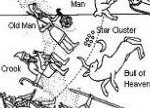The back side of the head of Ku came after the front side of his head:
And his head came first and his tail later - in normal fashion. However, if he as Leader was looking back - making sure the rest of his flock was following - it should mean the back of his head had to come before the front of his head. We can see this in the Hired Man:
"Aries generally has been figured as reclining with reversed head admiring his own golden fleece, or looking with astonishment at the Bull rising backward; but in the Albumasar of 1489 he is standing erect, and some early artists showed him running towards the west, with what is probably designed for the zodiac-belt around his body." (Allen)
They look at each other, Wether and Bull, when running away from each other, as if in mutual disgust, Taurus into summer and Aries into the past. In Babylonian times the head of Aries was earlier than 0h and it was his head which was important: "Among astrologers Aries was a dreaded sign indicating passionate temper and bodily hurt, and thus it fitly formed the House of Mars, although some attributed guardianship over it to Pallas Minerva, daughter of Jove whom Aries represented. It was supposed to hold sway over the head and face; in fact the Egyptians called it Arnum, the Lord of the Head ..." (Allen) In Gb4-8 I have up to now perceived a neckbreakingly upturned bird head - as if in vain looking for Polaris out of sight from Easter Island - but probably the intention was more to depict a 'bird' turning his head around to look into the past. What at first could be perceived as his pointed ear, could then be found to represent the 'horn' of Aries (The First Point of Aries). ... Several of the early missionaries comment with a fine sense of humor upon the mistake the islanders made in calling the cow when first seen a bird. This is the word which led the good missionaries into the error of their own ignorance. Manu is as wholesale in its signification as our word animal, it is generic. In the paucity of brute mammalia the first missionaries found this general term most frequently used of birds, and it was their and not a Polynesian mistake to translate manu into bird. In the material here collected it will be seen that the significations animal and bird are widely extended. In the Paumotu insects are included; the same is true of Mota, where manu signifies beetle as well as bird. Nor is its applicability restricted to earth and air; it reaches into the sea as well. Samoa uses i'amanu (fish-animal) for the whale ... A face (the front of the head) comes before the back of the head, with the mauga type of glyph as usual meaning 'last'. The face is bare and light, whereas the back of the head is hidden by hair:
Why was the Head of Ku a Hired Man? Possibly because he was a Mock King (interrex) serving in the dangerous time in the gap between a pair of regular years. ... 'In Upper Egypt', wrote Sir James G. Frazer in The Golden Bough, citing the observations of a German nineteenth-century voyager, 'on the first day of the solar year by Coptic reckoning, that is, on the tenth of September, when the Nile has generally reached its highest point, the regular government is suspended for three days and every town chooses its own ruler. This temporary lord wears a sort of tall fool's cap and a long flaxen beard, and is enveloped in a strange mantle. With a wand of office in his hand and attended by men disguised as scribes, executioners, and so forth, he proceeds to the Governor's house. The latter allows himself to be deposed; and the mock king, mounting the throne, holds a tribunal, to the decisions of which even the governor and his officials must bow. After three days the mock king is committed to the flames, and from its ashes the Fellah creeps forth ... However, such a dangerous time may have begun already at ω Piscium (Dzaneb), 33 days before Hamal. 411 - 33 = 378 (Saturn):
|
|||||||||||||||||||||||||||||||||||||||||||||||||||||||||||||||||||||||||||||||||||||||||||||||||||||||||||||||||||||||||||||||||||||||||||||||||||||||||||||||||||||||||||||||||||||||||||||||||||||||||||||||||||||||||||||||||||||||||||||||||||||||||||||||||||||||||||||||||||||||







